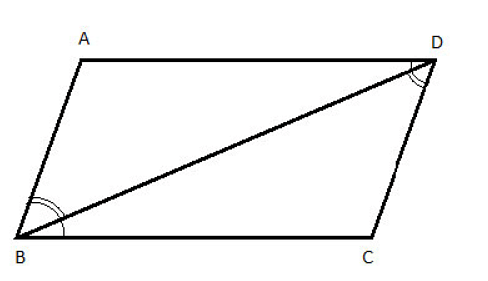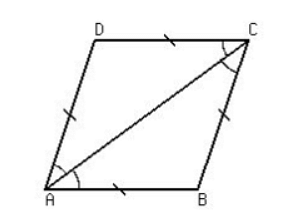
Content Curator
Parallelogram is a quadrilateral with two pairs of parallel sides. In total, it has 4 vertices, 4 angles, and 4 sides. The 4 interior angles add up to a total of 360°, and consecutive angles add up to 180°. The opposite angles of a parallelogram are equal. The diagonals of the parallelogram cross each other but not at right angles and are not equal as well.
| Table of Content |
Key takeaways: Parallelogram, Polygon, Angles, Sides, Diagonals, Congruence.
Properties of Angles of Parallelogram
[Click Here for Sample Questions]
Parallelogram is a polygon with 4 sides, which makes it a quadrilateral. Its distinct feature is that opposite sides are equal in length and are parallel to each other. One diagonal divides it into two congruent triangles, and its diagonals bisect each other. There are other factors about its angles that both set it apart from and it shares with other quadrilaterals, which are as follows:

Parallelogram
Property 1: The opposite angles of a parallelogram are congruent, which means that they’re equal. So here, ∠A = ∠C, and ∠B = ∠D.
Property 2: All 4 interior angles of a parallelogram add up to 360 degrees. So, ∠A + ∠B + ∠C + ∠D = 360 degrees.
Property 3: Consecutive angles in a parallelogram are supplementary, which means that they add up to 180 degrees. So, ∠A + ∠B = 180 degrees, ∠B + ∠C = 180 degrees, ∠C + ∠D = 180 degrees, and ∠D + ∠A = 180 degrees.
Read More:
Theorems & Proofs
[Click Here for Sample Questions]
Proofs and theorems help us better understand the various properties of parallelograms, which will make it easier to solve questions relating to them. Three theorems that are specific to angles in parallelograms are:
- Opposite angles are congruent
- If a quadrilateral has two opposite angles that are equal, then it’s a parallelogram
- Consecutive angles are supplementary
We can prove these theorems by drawing a diagonal across a parallelogram. A diagonal is a straight line that connects two opposite corners of certain shapes. Here's what it looks like in a parallelogram:

Diagonal of a Parallelogram
There are formulas that use a parallelogram’s diagonals to solve problems, which can be found here.
Also Read: Angle Sum Property of Quadrilateral
Now, let’s prove those two theorems.
Theorem 1: Opposite angles are Congruent.

Proof: The diagonal AC divides parallelogram ABCD into triangles ADC and ABC. If we superimpose those triangles together, we can see that:
- AC is a common side for both triangles, hence equal.
- By the law of alternate interior angles, ∠DCA = ∠CAB and ∠BCA = ∠CAD.
Based on the congruence of triangles, these two points prove that triangles ADC and ABC are congruent. This makes ∠CBA = ∠CDA, because they are corresponding parts of congruent triangles.
We can also conclude that ∠DAB and ∠DCB are equal because we know the values of those angles split in half - and the sums would naturally also be the same.
This proves our theorem that opposite angles in parallelograms are always equal.
Also Read:
Theorem 2: Every quadrilateral with equal opposite angles is a parallelogram.

Proof: We’re given that the opposite angles are equal, so ∠A = ∠C and ∠D = ∠B. We also know that the sum of interior angles in a quadrilateral is 360 degrees, which would be the case here too. So, with the information we have, we can conclude that:
∠A + ∠B + ∠C + ∠D = 360
Since ∠A and ∠C are the same, and ∠D and ∠B are the same, we can rewrite this equation as:
2(∠A+∠D) = 360; divide this whole equation by two and we get:
∠A + ∠D = 180
This proves that the consecutive angles are supplementary. Therefore, AD is parallel to BC and AB is parallel to DC. That makes it 2 pairs of parallel sides in a quadrilateral, which means that it’s a parallelogram.
Also Read:
Theorem 3: Angles beside each other on a parallelogram are supplementary.

Proof: We’re given that AB and CD are parallel to each other, and it is clear that AD is a transversal across those two lines. By one of the rules of transversals, interior angles beside each other on a transversal add up to 180 degrees, so 4 and 5 in the diagram below are equal. Referring this to the parallelogram given above, this means that:
∠A + ∠D = 180
∠A + ∠B = 180
∠B + ∠C = 180
∠C + ∠D = 180
This proves that supplementary angles in a parallelogram add up to 180 degrees.

Also Read:
Things to Remember
[Click Here for Sample Questions]
- All parallelograms have equal opposite angles and supplementary consecutive ones.
- The interior angles of parallelograms, like all other quadrilaterals, add up to 360 degrees.
- There are ways to prove these theorems with the help of laws from topics such as congruency, and transversals.
Also Read:
Sample Questions
Ques 1. The angles of a quadrilateral are in the ratio 3:5:9:12. What is the value of each angle? [5 marks]
Ans: All the angles in a quadrilateral add up to 360?, so (3+5+9+12) units = 360?
29 units = 360?
3 units = (3/29)x 360 = 37.2?
5 units = (5/29)x 360 = 62.1?
9 units = (9/29)x 360 = 111.7?
12 units = (12/29)x 360 = 148.9?
Ques 2. ∠A and ∠C are opposite angles in a parallelogram. ∠A = 75° and ∠C = (x+30)°. Find x. [3 marks]
Ans: Since ∠A and ∠C are opposite angles in a parallelogram, their values are equal. So,
x+30 = 75
x= 75 - 30
x = 45°
Ques 3. One angle is a parallelogram is 70°. Find the values of the rest of the angles. [3 marks]
Ans: We can use all the rules discussed earlier to solve this question. Since opposite angles in a parallelogram are equal, we know that the angle opposite to this one is also 70°. Since consecutive angles are supplementary, the other two angles are (180 - 70 = 110)°. So, the remaining angles are 70°, and two of 110°.
Ques 4. Two angles beside each other in a parallelogram are in the ratio 4:5. Find their values. [3 marks]
Ans: This uses the supplementary rule of angles of a parallelogram. So,
4x + 5x = 180
9x = 180
x= 20
Now, to find the value of each angle, we just need to multiply the value of x by the respective ratios:
4x = 4 x 20 = 80°
5x = 5 x 20 = 100°
Ques 5. The values for two opposite angles in a parallelogram are (4x - 5)° and (3x - 2)°. Find the values of these angles. [3 marks]
Ans: Since they are opposite angles, they are equal to each other. Hence,
4x - 5 = 3x - 2
4x - 3x = -2 +5
x = 3
To find the values of the angles, we just need to insert the value of x into the given expressions.
4x - 5 = 4(3) - 5 = 7°
3x - 2 = 3(3) - 2 = 7°
These results make sense because they’re opposite angles, and they’re supposed to be equal.
Ques 6. Find the values of x, y and z in the given diagram. [5 marks]

Ans: We can use the opposite angles are equal and adjacent angles add up to 180° rule to solve this question. This can be done by making simultaneous equations and solving them.
(2x +3) = (y +x)
y+ (y+x) = 180°
Simplify these equations,
x = -3+y….. 1
x+2y =180……2
Insert equation 1 into equation 2
(-3+y) +2y = 180
-3+3y =180
3y = 180+3 = 183
y= 183/3 = 61°
Now that we’ve found the value of y, we can insert it into any of the above equations to find x.
x = -3+61
x = 58°
y and z are opposite angles, so they’d be equal. So,
Z = 61°
Ques 7. Find the value of x in the following parallelogram. [3 marks]

Ans: ∠D and ∠B are opposite angles in a parallelogram, therefore they’re equal. We can translate this into an equation to find x:
x+25 = 85
x = 85 - 25
x = 60
Ques 8. Find the value of x in the parallelogram shown below. [3 marks]

Ans. We can use the rule of adjacent angles being supplementary to find x here.
3x + x = 180
4x = 180
x = 180/4 = 45°
Also Read:





Comments